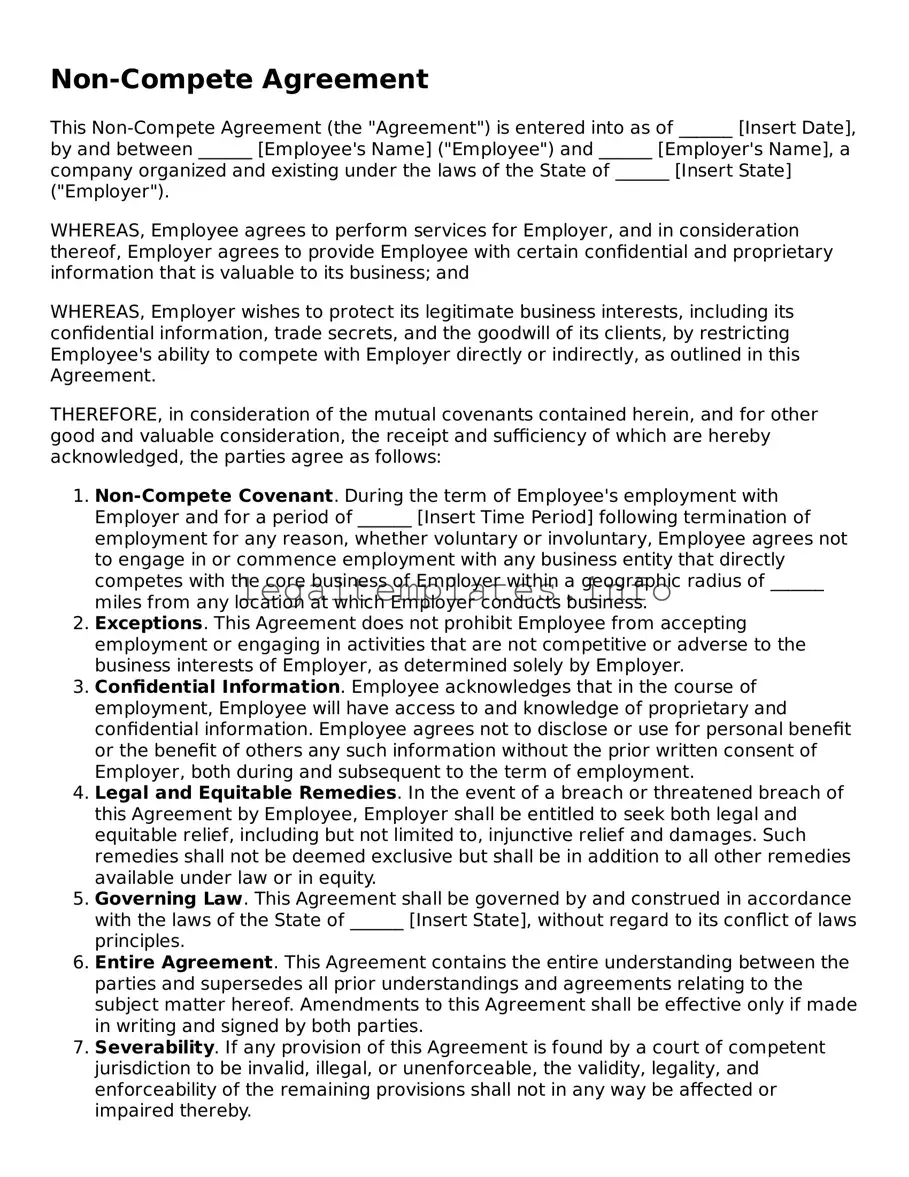Non-Compete Agreement
This Non-Compete Agreement (the "Agreement") is entered into as of ______ [Insert Date], by and between ______ [Employee's Name] ("Employee") and ______ [Employer's Name], a company organized and existing under the laws of the State of ______ [Insert State] ("Employer").
WHEREAS, Employee agrees to perform services for Employer, and in consideration thereof, Employer agrees to provide Employee with certain confidential and proprietary information that is valuable to its business; and
WHEREAS, Employer wishes to protect its legitimate business interests, including its confidential information, trade secrets, and the goodwill of its clients, by restricting Employee's ability to compete with Employer directly or indirectly, as outlined in this Agreement.
THEREFORE, in consideration of the mutual covenants contained herein, and for other good and valuable consideration, the receipt and sufficiency of which are hereby acknowledged, the parties agree as follows:
- Non-Compete Covenant. During the term of Employee's employment with Employer and for a period of ______ [Insert Time Period] following termination of employment for any reason, whether voluntary or involuntary, Employee agrees not to engage in or commence employment with any business entity that directly competes with the core business of Employer within a geographic radius of ______ miles from any location at which Employer conducts business.
- Exceptions. This Agreement does not prohibit Employee from accepting employment or engaging in activities that are not competitive or adverse to the business interests of Employer, as determined solely by Employer.
- Confidential Information. Employee acknowledges that in the course of employment, Employee will have access to and knowledge of proprietary and confidential information. Employee agrees not to disclose or use for personal benefit or the benefit of others any such information without the prior written consent of Employer, both during and subsequent to the term of employment.
- Legal and Equitable Remedies. In the event of a breach or threatened breach of this Agreement by Employee, Employer shall be entitled to seek both legal and equitable relief, including but not limited to, injunctive relief and damages. Such remedies shall not be deemed exclusive but shall be in addition to all other remedies available under law or in equity.
- Governing Law. This Agreement shall be governed by and construed in accordance with the laws of the State of ______ [Insert State], without regard to its conflict of laws principles.
- Entire Agreement. This Agreement contains the entire understanding between the parties and supersedes all prior understandings and agreements relating to the subject matter hereof. Amendments to this Agreement shall be effective only if made in writing and signed by both parties.
- Severability. If any provision of this Agreement is found by a court of competent jurisdiction to be invalid, illegal, or unenforceable, the validity, legality, and enforceability of the remaining provisions shall not in any way be affected or impaired thereby.
- Binding Effect. This Agreement shall be binding upon and inure to the benefit of the parties hereto and their respective heirs, executors, administrators, legal representatives, successors, and assigns.
IN WITNESS WHEREOF, the parties have executed this Non-Compete Agreement as of the date first above written.
EMPLOYEE: ___________________________
EMPLOYER: ___________________________
